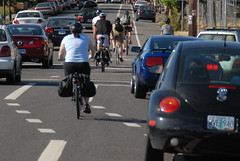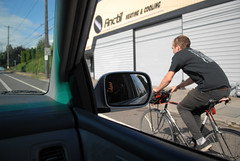A much anticipated project to improve the bikeway on North Williams Avenue will officially begin on February 1st when the Stakeholder Advisory Committee meets for the first time. But when a hand-picked group of neighborhood leaders and business owners sit down to come up with how to improve the street, they won’t have just the bikeway in mind.
The project is now officially called the “North Williams Traffic Operations Safety Project.” It’s one of several “bikeway development projects” we first shared news about back in May. PBOT kicked off the public process for the Lloyd District projects last month.
In addition to the first stakeholder meeting, PBOT has also launched the official webpage for the Williams project. What’s notable is the way PBOT is framing this. What began as a bikeway development project seems to have expanded in scope to more of a general, transportation safety project with an improved bikeway as just one potential element. The official name of the project makes no mention of bicycles.
Here’s how PBOT describes the purpose and objectives:
The purpose of this project is to make traveling on North Williams Avenue between Weidler and Killingsworth safer and more comfortable for all users.
Here are the six project objectives the PBOT project team has identified:
- To conduct an open planning process through which all voices can be heard by the City.
- To reduce or manage traffic conflicts between people bicycling, people driving, and buses operating on North Williams. (Notice how they use “people bicycling” and not “bicyclists!”)
- To improve conditions for bicycling on North Williams.
- To maintain or improve conditions for walking on or across North Williams.
- To explore innovative solutions and strategies.
- To create conditions for transit service, traffic flow, parking and active transportation that support existing businesses and future business development.
That list makes it clear that PBOT wants the public to see this project as being — not focused solely on a new bikeway — but on improving the safety and function of the street in general. I like that approach, but I also wonder what has motivated them to take it.
Is this approach a trickle-down result of Mayor Adams’ distancing himself from bicycles? Does it have to do with PBOT’s fears that bicycling is seen as a symbol of gentrification in this neighborhood that was once a thriving African American community? Is their recent project on SE Holgate that led to a neighborhood revolt and cries of a “bike lane take-overs” causing them to use a bit more caution?
It’s likely all of those things are having some impact. But there are also some very good reasons to approach the project like this.
Michelle Poyourow — the former BTA staffer turned consultant hired by the City of Portland to manage the public outreach on this project — has been working behind the scenes since October to learn more about what the neighborhood thinks about Williams.
In door-to-door conversations with residents along the Williams corridor, Poyourow heard three main complaints. The top complaint was speeding (cars), the next was the well-known bus and bike “leapfrog” phenomenon, and the third top complaint was that compliance with crosswalk laws is very low (people on bikes and in cars are not stopping to let people cross the street).
Ellen Vanderslice is the PBOT project manager in charge of the project. In a recent conversation, she explained PBOT’s approach:
“We recognize that nothing can get implemented without broad public endorsement; so let’s start finding out the issues and opportunities and the things that are important to people… We need to understand the stakeholder issues and we need the stakeholders to feel like they’re engaged from the beginning of the discussion and not that we’ve got a solution we want to sell to them.”
With the change in tone from a bikeway project to a “traffic operations safety” project, it will be very interesting to watch how this process evolves and what design options are left on the table at the end of it. I think it’s very smart of PBOT to approach projects in a non-mode specific way — but at the same time I have some reservations about what might happen if it’s not made absolutely clear from the start that the impetus for the project to begin with was to create a world-class bikeway.
Stay tuned for more coverage of this project.



